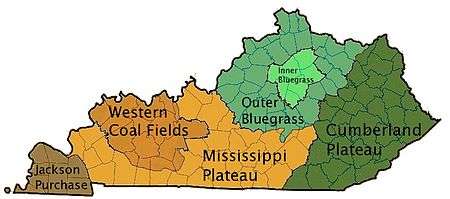Western Coal Fields

The Western Coal Fields of Kentucky compose an area in the west-central part of the state, bounded by the Dripping Springs Escarpment. This area is bordered on three sides by the Pennyroyal Plateau and to the north by the Ohio River.[1] It is characterized by Pennsylvanian age sandstones, shales and coal seams. Nearly all of the counties in the area are part of the Kentucky-Illinois-Indiana Tri-State Area.
Included areas
The Western Coal Field region of Kentucky includes all of the following counties:
- Butler County
- Daviess County
- Grayson County
- Hancock County
- Henderson County
- Hopkins County
- McLean County
- Muhlenberg County
- Ohio County
- Union County
- Webster County
Additionally, the region includes parts of the following counties:
- Breckinridge County
- Christian County
- Edmonson County
- Hart County
- Logan County
- Todd County
- Warren County
Not all these counties, and not all of the Western Coal Field, contain coal. The term is used to define the region with Pennsylvanian-age strata, largely sandstone and shale, in contrast to the Mississippian-age limestone of the adjoining and older Pennyroyal region. A transitional zone, generally defined as being part of the coalfield region, is the Clifty Area, where the rock outcrops include bituminous sandstone, or tar sands, which have commercial value as paving material.
The biggest concentration of surface mines in this region has historically been along the edges in Hopkins, Muhlenberg, and Ohio Counties. All three counties still contain a very large amount of coal and have active mining, surface and underground, operations taking place. The use of power shovels and draglines were very common in these counties where the coal would lay as close as 60–80 feet from the surface. This is a region that was considered to be the largest producer of coal in the world from the 1960s through part of the 80s until it dramatically dropped in the early 90s after the passage of clean air regulations. The largest mining company founded during the 30-year span of prosperity became Peabody Coal Company (Peabody Energy), whose corporate offices were located in the region in Henderson, Kentucky, at the time. A combination of economic shifts and industry contributed to a decline in coal field production starting in the early 1970s. Western Kentucky coal field production has risen since 2004. In 2012 Western Kentucky coal production exceeded Eastern Kentucky production for the first time since 1960. Higher petroleum fuel costs and the mandated installation of sulfur scrubber technology in eastern power plants has made high-sulfur Western Kentucky coal more economically competitive than in the past. In 2003 Armstrong Coal Company started to lease a large chunk of property in the region from Peabody Energy so that they could recover the coal. The reason for this is the demand for Western Kentucky Coal has once again spiked to levels not seen since the 1970s.[2]
See also
References
- ↑ "Geographical Configuration". Encyclopedia of Kentucky. New York, New York: Somerset Publishers. 1987. ISBN 0-403-09981-1.
- ↑ http://energy.ky.gov/Coal%20Facts%20Library/Kentucky%20Coal%20Facts%20-%2013th%20Edition%20%282013%29.pdf
